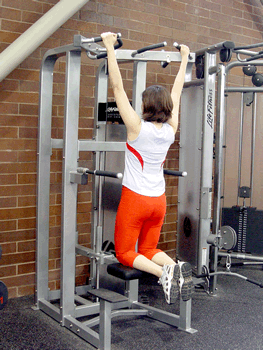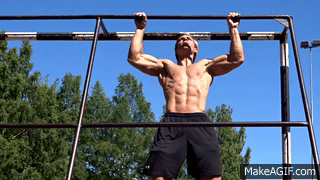
What are pull-ups?
Pull-ups are one of the original strength and muscle building exercises. They target the muscles in the back as well as activate the bicep muscles. The beauty of pull-ups is their simplicity. You do not need any weights or special equipment, just a bar to pull on.
Many people struggle with this exercise but the problem is usually related to grip strength rather than upper body strength. In this article we will explore pull-ups, the muscles worked, how to perform them and how to get the best from them.
Which muscles are targeted with pull-ups?
The main aim of the pull up is to increase strength and mass in the back. The primary movers are the Latissimus Dorsi, the Rhomboids and the trapezius.
The posterior deltoids are also activated to a lesser extent but can still be considered a primary mover. This makes pull-ups a great exercise for the entire upper mid and upper back.
There are quite a few secondary movers with pull-ups. The biceps, forearms, pectorals and core muscles all assist with stabilisation and the pulling motion.
Combined with the primary muscles engaged, this is a lot of muscle activation in one compound movement which is why it is so popular with advanced trainers.
How do I perform a pull-up?
Most of you will have seen pull-ups being performed in the gym but may not have taken much notice of the grip used. It is easy to get mixed up between a pull-up and a chin-up.
Chin-ups will use an underhand, close grip which places a lot more emphasis on the biceps and isolates the lats, a pull up is performed with a wider, overhand grip which allows it to engage the traps and rhomboids to assist the lats with the movement.
Both are great exercises and both have their benefits but for overall back development, the focus should be placed on the pull-up.
- Find a bar that is just above your standing reach. Most twin cable stations, dip stations or squat racks will have pull up bars attached to the top of them in your gym.
- Jump or use a step so that you can grip the bar. Use an overhand grip wider than your shoulders.
- Cross your legs and keep a straight back. Pull yourself upwards until your chin is over the bar.
- Make sure that you can feel the connection with the muscles in your back,
- When you get to the top, lower yourself in a controlled motion.
- Don't allow your arms to straighten and elbows to lockout. Keep the tension by keeping your arms slightly bent at the bottom of the motion and pull yourself straight back up.
- Repeat for the required number of reps and sets.
Do not start to swing yourself backwards and forwards whilst doing this exercise, Stick to a straight up and down motion with a rigid body. If you find it too easy, you can add resistance by wearing a weighted belt or putting a barbell plate between your legs.
Alternatives to a standard pull up.
Many gyms now feature an assisted pull up machine. These are great if you are a beginner or are just starting to add pull-ups to your routine. They allow you to use an adjustable counterweight so that you can work on technique and grip strength.
Assisted pull up machines are also a great way to warm the back up for a deadlift or row session.

Assisted pull up machines are simple to use. Simply select your counterweight from the weight stack, fold down the knee pad and climb on.
From this point, grab the pull up bar and perform the motion as you would for a traditional pull-up.
Some assisted machines will have footplates instead of knee pads but they all do exactly the same thing and work the same muscles.
These machines are also good for chin-ups and assisted dips.
Alternative back exercises.
Lat pull-downs
Bent over rows
Row machine
Take away
We hope that you have found this article informative and that you now know the answer to the original question - what are pull ups?
Check out our free training programs by clicking on the menu bar at the top of this page.

